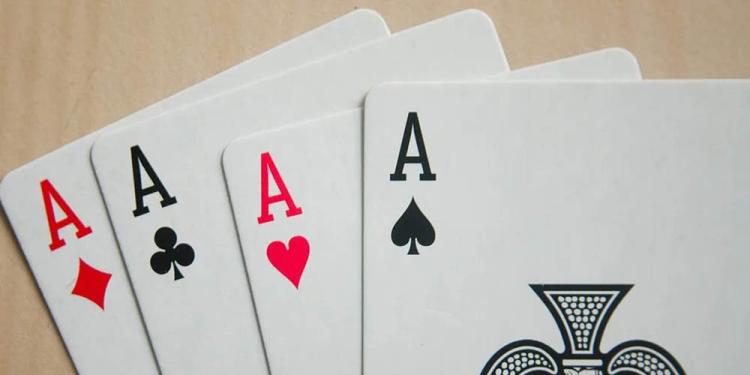The Ace of Spades and the Vietnam War
Posted: March 25, 2020
Updated: March 25, 2020
Just a warning that this is going to be a deep dive into the more macabre uses of playing cards. In particular the use of the Ace of Spades during the Vietnam war of 1954 to 1975. If you've seen the 1979 Francis Ford Coppola war epic, Apocalypse Now, then you'll probably remember the US soldiers throwing Ace of Spade cards onto the bodies of Vietnamese soldiers.

Just a warning that this is going to be a deep dive into the more macabre uses of playing cards. In particular the use of the Ace of Spades during the Vietnam war of 1954 to 1975. If you’ve seen the 1979 Francis Ford Coppola war epic, Apocalypse Now, then you’ll probably remember the US soldiers throwing Ace of Spade cards onto the bodies of Vietnamese soldiers.
Introduction: The Ace of Spades and the Vietnam War
This was a form of psychological warfare, to promote the ideas of fear and dread into those dead soldiers. The US serving soldiers were all issued with standard playing cards as there was a great deal of “downtime” between combat missions. Today they would probably be playing at one of these online poker sites in the US. The practice of flinging cards onto the fallen enemy appears to have come about during this conflict and was instigated by those US soldiers who were serving in Vietnam at the time.
The Origins of the Ace of Spades
Steeping back into history, the Ace of Spades has a long and fruitful relationship with death. The meaning of this card comes from medieval times. In Germanic Europe, the actual card symbol comes from Germanic myths and Yuletide festivals. In other words, it was used to mark the beginnings of Winter. The common people feared these cold months. Often this season bought nothing but starvation and death. Not surprisingly, this is from where the card’s reputation originates. And over time, the card and this associated meaning worked themselves into popular culture and became a macabre symbol for soldiers everywhere.
First a Symbol of Good Luck
Though the card was to surface more during the period of the Vietnam conflict, it was seen earlier. During World War II. Then US soldiers took to wearing their helmets with a painted Ace of Spades as a symbol of good luck. But the reference was towards good fortune. It was a universal sign among “friendlies”. However, during the Vietnam war, it took on a much more sinister tone. The intention behind this altogether darker. It was a means to play on the unknown superstitions of the North Vietnamese people. Yet there absolutely no proof that the Vietnamese people saw the Ace of Spades as anything other than one of many normal playing cards.
Then a Symbol of Bad luck
But for the US troops, it was thought that this symbol, charged with morbid meaning, was well-known to the Vietnamese, and so would strike fear and humiliation into their hearts. So what essentially started as a rumor, quickly gained legs and rapidly spread among the US soldiers as a means of terrifying the enemy. To accelerate the myth, in 1966 a group of officers from the 25th Infantry Division, wrote to the US Playing Card Company in Cincinnati. They asked for 1,000 decks of playing cards, but with only the Ace of Spades in them. To their great surprise, the card company complied and sent them free of charge. The US media picked up on the story, and suddenly it moved from myth to fact, that the Vietcong had a mortal fear of the Ace of Spades.

Let The Media Do Its Job
The newspapers, always quick to draw on fiction as opposed to facts, presupposed that the Vietnamese people had become acquainted with playing cards during the French colonial rule. So they must surely associate the cards with decades of foreign rule and unwanted influence. Also, according to online poker news in the US, the US playing cards featured the image of a woman on one side of the Ace of Spades. Somehow this was also construed as offensive and an omen of bad fortune to oriental eyes. To add a sense of perspective, there is an interview with a certain Captain Blaine Revis of the Military Assistance and Advisory Group. He remarks to a reporter that, “We Americans look at the ace of spades as the death card. But to the Vietnamese, it is more like a phallic symbol. If anything it might suggest that we were involved in necrophilia.”
Military Use
With the growing popularity of this particular playing card, we started to see them more and more, both on the battlefield and off. Soldiers took to wearing them in their helmet bands. They often posed for photos whilst brandishing an Ace of Spades. They were placed on the eyes of the deceased enemy with the implication that the Ace of Spades was the last thing they saw. The symbol then appears in leaflets that were dropped on enemy positions and villages. Often pictured together with a skull, these warned the Vietnamese of impending death if they did not give up their war efforts.
Apocalypse Now and Into The Mainstream
Thanks to the movie, Apocalypse Now, the card finally gained fame and notoriety. They were out of the military and in with the general public. The Ace of Spades became a symbol of the war itself. Another soldier makes an interesting point during a wartime interview. ” Did it work? I’m not sure. Did it help our morale? I definitely think so! In our company and others throughout Vietnam, I think the cards did something to encourage the men that were just trying to survive during a difficult time.”

Modern Death Cards
In more modern times, playing cards and war once again came into the public eye. During Operation Iraqi Freedom, the US military had playing cards produced. These bore the faces of their most wanted officials on the fronts. The “death card” or Ace of Spades bore the photo of nonother than Saddam Hussein himself.
Of course, today, you can find playing cards of all types of design at your online poker sites. Check out some at Intertops Poker.
You can discover more about Intertops Poker here.












